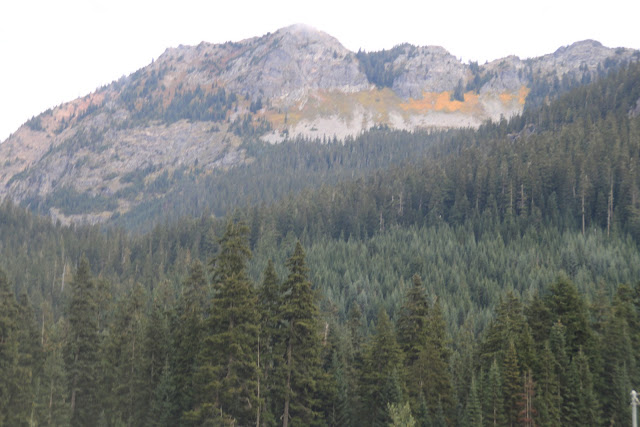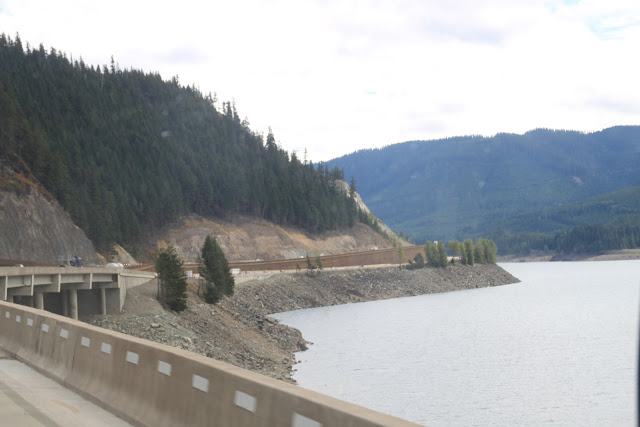The lanes kept getting more narrow as we inched our way forward. But we couldn't turn around or go back so kept following the maze.
Turns out we picked the wrong lane and wound up with a barrier in front of us and a very sharp curve to go around that we couldn't maneuver with the rig.
They were nice and saw our dilemma (I don't think we were the first ones to do this) so they moved another barricade to allow us to go over to the section where the trucks went through. It was a tight area to get the rig in and out of but we made it and were back in the United States!
It was a three day drive to Boise and we saw some great scenery along the way. The Captain also noticed the engine thermostat on the rig was getting too high, almost into the red zone, whenever we went up inclines in the mountains so we decided to get it checked out at a Cummins Service Center while in Boise.
Each day as we drove further south the landscape became drier looking. Much of the area is desolate because of the lack of water sources.
 |
| Mount Baker in the distance. We never realized the eastern side of Washington was so arid. |
 |
| But thanks to big rivers and expert irrigation the valleys were green and lush with towns and farms. |
 |
| A crop of hops used to make beer. Washington is the largest producer of hops in the nation. |
Then we headed through Oregon and it was arid, too, with miles and miles of solar panels creating energy.
We stayed at a nice RV park in Caldwell outside of Boise, Idaho.
Since we got into the area on a Saturday we had to wait until Monday to get the rig into the service center. They looked at it, replaced some very dirty filters, flushed the outside of the radiator which was full of dirt, then topped off the radiator with more fluid. The trip to Alaska and back had taken its toll with all the dusty roads we had been on. They thought that was the only problem and sent us on out way.
While in the Boise area we took the pups on a hike to Lake Lowell which is the first reservoir built in the Boise Water Project. The project took more than fifty years to complete and includes 6 major reservoirs, 2 diversion dams, 3 power plants, and over 2,500 miles of canals, ditches, and drains. It supplies water to 390,000 acres of land in one of the west's most productive farming regions. Without Lake Lowell and other parts of the Boise Project much of southwest Idaho could not have been settled.
Thousands of people crossed southwest Idaho's fertile soils on the Oregon Trail but few stayed in the parched landscape. That changed in 1862 when gold was discovered near Idaho City. By 1864, farmers had settled all the easily-irrigated land next to rivers to supply the miners with food. Investors soon built private canals and charged to deliver water to farms further from rivers. As western irrigation projects grew more expensive and complex, private companies weren't up to the challenge. In 1902, President Roosevelt established the Reclamation Service to help irrigate arid lands by storing runoff water in large reservoirs. Deer Flat Reservoir was one of the first reclamation projects.
Although originally built for irrigation, President Theodore Roosevelt realized that a lake in the desert could also be a wildlife oasis. So in February, 1909, just three days after the Boise River water was released into one of the canals to begin filling the reservoir, he set aside 12,000 acres to create Deer Flat National Wildlife Refuge.
 |
| Nests of swallows on a column of Lake Lowell.
Boise is a dynamic city with a youthful vibe. The city is along the Boise River and there are miles and miles of trails to walk or bike on.
|
 |
| Note the fine print.
The city is full of restaurants with outdoor eating areas that welcome dogs and beautiful city center parks.
 |
One of the neatest things we saw was an alley dedicated to graffiti with amazing murals on the outside walls of the buildings. Freak Alley is a venue for public art in the form of murals and graffiti. It is the largest gallery in the Northwest and a Boise institution since 2002. It began with a painting of a single alley doorway. Extant murals are painted over and replaced by new murals every two years and collectively it is the work of more than 200 artists.
 |
| Many of the downtown buildings have been refurbished. This building was once the Central Fire Station built in 1903. |
 |
Part of the trail runs alongside the zoo and we saw these giraffes enjoying their day. |
 |
| The trees on the far side of the river show how strong the current can be. |
This piece of artwork is called "The Other". An individual perceived by the group as not belonging, as being different in some individual way.
 |
The Idaho Anne Frank Human Rights Memorial honors the triumph of the human spirit. In a world divided by differences of political doctrine and religious beliefs, we are humbled and emboldened by a child who wrote in her diary from the silence and dread of her family's hiding place in Amsterdam during World War II. The diary is among the most widely read books in the world. It has been translated into more than sixty languages and is regarded by historians as one of the most important documents of the 20th century. In 1943, Anne Frank was imprisoned at Bergen-Belsen concentration camp where she died of starvation, exposure, brutality, and disease. She was fifteen years old.
"In Germany they came first for the Communists, and I didn't speak up because I wasn't a Communist. Then they came for the Jews, and I didn't speak up because I wasn't a Jew. Then they came for the trade unionists, and I didn't speak up because I wasn't a trade unionist. Then they came for the Catholics, and I didn't speak up because I was a Protestant. Then they came for me, and by that time no one was left to speak up". - Martin Niemoeller, German Protestant Minister who was leader of the Church's opposition to Hitler. He was interned in Nazi concentration camps from 1937-1945.
With great sadness, Brett and I look at the state of our country today and are surprised and bewildered at the bigotry, racism, misogyny, and hatred embraced by the current political party now in power. We never would have believed it could happen in the United States of America and yet all one hears is bullying tactics and verbal abuses coming from a man who is currently president. The fact that some people agree with him and cheer him on is depressing.
The final version of the Declaration of Independence declares: "We hold these truths to be self-evident, that all men are created equal, that they are endowed by their Creator with certain unalienable Rights, that among these are Life, Liberty, and the pursuit of Happiness". That means people of all colors, religions, gender and ethnicity have equal rights. That was the backbone of this country when it was formed by immigrants and it should remain a country for all people.
It is time for those of us who have remained quiet to take action. Vote this fall, write to your congressmen, rally and protest to save this country from the mean-spirited words and actions that have become too prevalent from an administration that is destroying our country and our way of life.
Elie Wiesel was a Jew who was interned during the Second World War and lost his entire family to the Nazis. After the war he became a writer, political activist, Nobel Laureate, and authored 57 books, several based on his experience in the Auschwitz and Buchenwald concentration camps. While he was in the camps he made this vow:
"I swore never to be silent whenever and wherever human beings endure suffering and humiliation. We must always take sides. Neutrality helps the oppressor, never the victim. Silence encourages the tormentor, never the tormented".
It is time for us to speak out and save this country. Peace!























































No comments:
Post a Comment